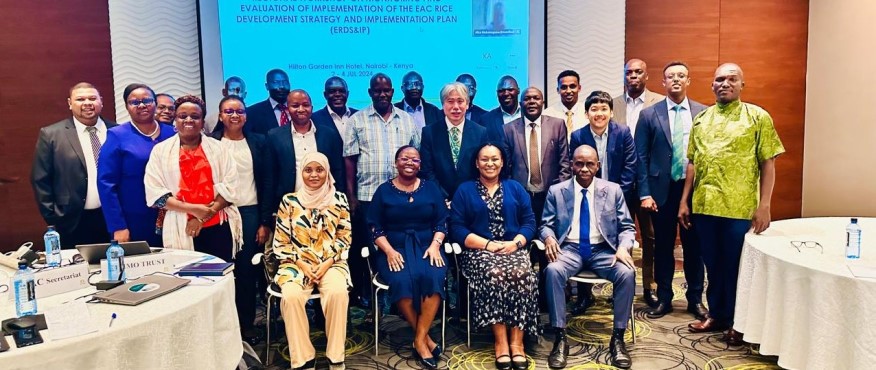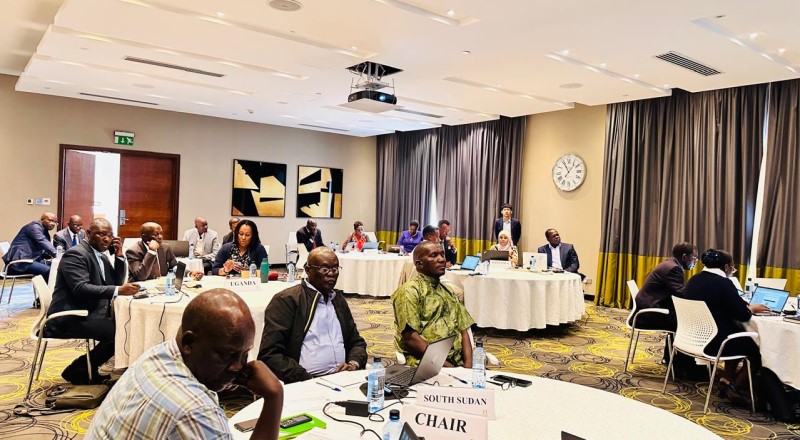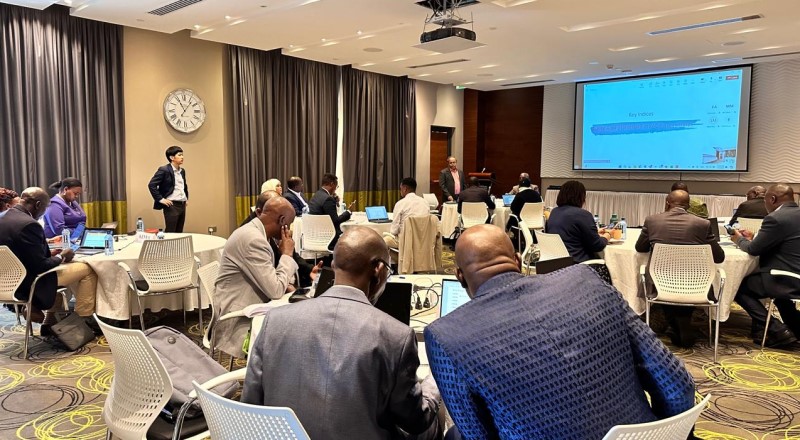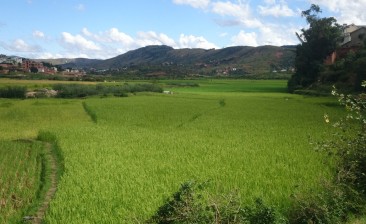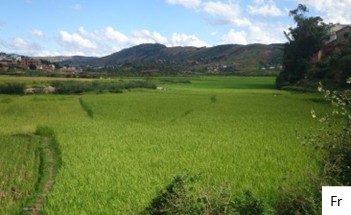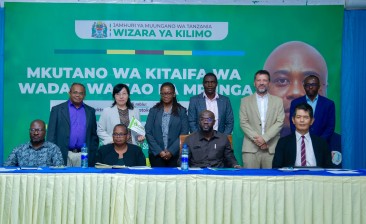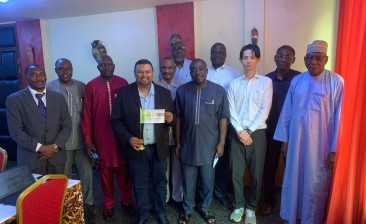EAC Rice Development Strategy (ERDS), July 2024
Kick-Off Meeting on Monitoring & Evaluation of EAC Rice Development Strategy (ERDS)
East African Community (EAC) is an intergovernmental organization promoting economic integration amongst its Partner States viz., Burundi (BDI), Democratic Republic of Congo (DRC), Kenya (KEN), Rwanda (RWA), Somalia (SOM), South Sudan (RSS), Tanzania (TZA) and Uganda (UGA). Although rice is not a traditional food crop, recent studies conducted by Kilimo Trust show that rice has become the second most important food crop in the EAC region. With technical guidance from CARD/JICA, the individual EAC Partner States (with the exception of Somalia) have either completed formulation or in the process of formulating their National Rice Development Strategy (NRDS). In general, the NRDSs of these states focus on achieving self-sufficiency in rice by increasing total production and productivity in their respective countries. Despite a growing inter-connectivity of markets for both the inputs and outputs of rice farms in the EAC region, the NRDSs of the Partner States do not adequately address the need for coherence of rice sector development in the region as a whole.
EAC Secretariat established an EAC Rice Platform (ERP) in 2020 to improve coordination of rice value chain advancement amongst the Partner States. With technical guidance from CARD, the ERP formulated and validated EAC Rice Development Strategy (ERDS; 2023-2030). The ERDS aims to double the rice production by facilitating free movement of goods, services and capital investments along the rice value chain in the region. Implementation Plan for the ERDS (ERDSIP) outlines various activities and outputs that could lead to doubling of rice production in the region through cohesion, integration and cooperation amongst the Partner States. To initiate annual assessment of progress on the implementation of the ERDS, the EAC and CARD Secretariats organized a workshop for the ERP members and the NRDS Focal points of the EAC Partner States. Through this activity, the ERP members are expected to reach consensus on indicators for annual monitoring and evaluation (M&E), self-assign responsibilities for data collection, identify gaps in funding for implementation, and prioritize concepts that need immediate attention from regional stakeholders.
Kick off meeting on M&E in Nairobi
The workshop was organized in Nairobi between 2nd July and 4th July, 2024. About 19 participants (3 each from RSS, KEN and UGA, and 2 each from BDI, DRC, RWA, SOM and TZA) from EAC Partner States participated in the workshop. While 17 participants were physically present at the workshop, the participants from Rwanda joined online due to delays in getting their travel-approval. Two representatives from the EAC Secretariat and one resource person from Kilimo Trust also attended the workshop.
Consensus on indicators and data collection protocols
Upon finalization and adoption of the ERDS in 2023, this EAC workshop aimed on designing monitoring and evaluation framework to assess the ERDS implementation during the CARD phase 2. To facilitate achievement of this objective, an overview of CARD Phase 2 M&E framework highlighting the RICE (Resilience, Industrialization, Competitiveness and Empowerment) approach and the proposed methodology to design the ERDS M&E framework by adopting the CARD M&E Overall-RICE approach were presented to the participants. In addition, the criteria applied to select the proposed ERDS M&E indicators obtained from the ERDS document based on Overall-RICE approach and the set of proposed indicators were presented. The EAC partner state representatives unanimously concurred to adopt the proposed Overall-RICE approach framework and ensued into an extensive discussion to reach a consensus on the indicators with each partner state critically reviewing the set of proposed indicators, selecting and finetuning them. Resultantly, the participants reached consensus on 13 M&E ERDS indicators comprising of 4 indicators under Overall (O) category, 2 indicators each in Resilience (R), Industrialization (I) and Competitiveness (C) categories and 3 indicators in Empowerment (E) category to monitor and evaluate the ERDS implementation. Furthermore, the participants identified data sources for each indicator and designated data collection responsibilities to each partner state NRDS Focal Point through a consensual agreement as delineated in the table below:
| Code | Indicator | Unit | Data need | Data source |
| O1 | Cumulate quantity of paddy produced in the EAC region | Tons | Secondary | Statistics unit in MOA (Ministry of Agriculture) |
| O2 | Cumulative Rice Area harvested in the EAC region | Ha | Secondary | Statistics unit in MOA (Ministry of Agriculture) |
| <includes Rainfed, irrigated upland & other ecosystems prevalent> | ||||
| O3 | Average Yield | t/Ha | Secondary | O1/O2 |
| O4 | Regional Self-Sufficiency rate | % | Secondary | Statistics unit in MOA (Ministry of Agriculture), National Banks, Office of Burundi Revenue, Ministry of Trade (with breakup of sources: EAC and non-EAC) |
| <Regional Self-Sufficiency rate= (Cumulative total rice produced in the region/Cumulative total rice consumed in the region) *100> | ||||
| R1 | Number and types of new climate smart “technologies” disseminated in 2 or more partner states through regional interventions | unit | Secondary | Regional project reports |
| <such as improved varieties, water-saving technologies, regenerative practices, small machineries and other technologies mentioned in the ERDS document-often delivered by CG centers, AGRA> | ||||
| R2 | Quantities of seeds of resilient varieties (that are registered in 2 or more Partner states) produced on the region | Tons | Secondary | Seed Certifying agencies/Institutions |
| <Certified seeds only; resilient to biotic and abiotic stresses | ||||
| I1 | Number of new rice processing mills ((I-1a) built and/or (I-1b) upgraded through regional interventions | % | Secondary | Regional Project reports |
| <include “all”-small, medium and large mills> | ||||
| I2 | Number of rice farm machineries (tractors, transplanters and combined harvesters) imported by Partner States from regional private vendors in the region | Units | Secondary | Customs |
| <Number, type and sources> | ||||
| C1 | Share of EACs intraregional rice trade flow volumes in total imports of rice (Share=(Total rice volumes imported from within the region/Total volume of rice imported by the region)*100)) | % | Secondary | Statistics unit, National Banks, office of Burundi Revenue, Ministry of Trade (with break-up of sources: EAC and non-EAC) |
| C2 | Quantities of seeds of high yielding varieties produced in and disseminated in to 2 or more Partner states in the region through regional interventions | ton | Secondary | Seed Certifying agencies/institutions |
| <Varieties yielding above national average or national standard variety> | ||||
| E1 | Number of farmers (including women and youth) trained (including exchange visits) on rice value chain activities (production-marketing) through regional interventions | Unit | Secondary | Regional Project reports |
| <Training includes various extension approaches including TOTs, FFS, Demonstrations, etc> <Includes Associations, Farmer groups, Cooperatives> | ||||
| E2 | Number of sensitization meetings on policy coherence between Partner States in the EAC region | Unit | Secondary | Regional Project Reports, EAC Annual report, National Policy documents |
| E3 | Number of trained rice researchers, extension agents and technicians at EAC level (Trained through regional training programs-EAC, DPs, IRRI, AfricaRice, etc.) | Unit | Secondary | Regional Project Reports, EAC Annual report |
| <includes both public and private sector> |
Analyses of gaps in current interventions
Since the validation of the ERDS, CARD and EAC had elaborated the technicalities of a concept on ‘seeds without border (SWB; one of the key activities proposed under ERDS’ Implementation Plan) and submitted for funding from FAO. Due to limitations in resources of the FAO however, funding for SWB was also sought from AfDB. AfDB has now accepted to sponsor SWB activities and further included a major component on extension services for farmers growing rice (and also maize and cassava) in the EAC region, through a new grant-project entitled ‘Enabling Sustainable Regional Extension (ENSURE; 2024-2027)’. In addition, JICA has recently evinced support for regional interventions on mechanization under the ERDS (on pipeline). Besides these two new projects, there are a few on-going policy actions (such as irrigation strategy and seed bill) and projects from USAID, IKEA Foundation, KOICA and AGRA are addressing issues such as soil fertility, pesticide usage, and circular economy of rice production in EAC Partner States.
To identify gaps in funding for rice value chain development in the EAC region, the participants used a Subsector Intervention Element Matrix (SIEM) wherein the value chain segments could be cross-checked for various intervention elements (table below). Because the ERDSIP had already outlined the interventions needed (demand) along the rice value chain in the EAC region, the participants first mapped the current interventions (projects and policy actions) onto the SIEM. Gaps in the value chain were then prioritized by the participants using color codes, wherein red-shaded cells represent areas where interventions are extremely inadequate, yellow shades represent areas where some activities are currently taking place but not sufficient enough, and white (blank) cells represent areas which need attention but could wait until after the available resources meet the perceived needs in red and yellow cells. (graph shows as image below)
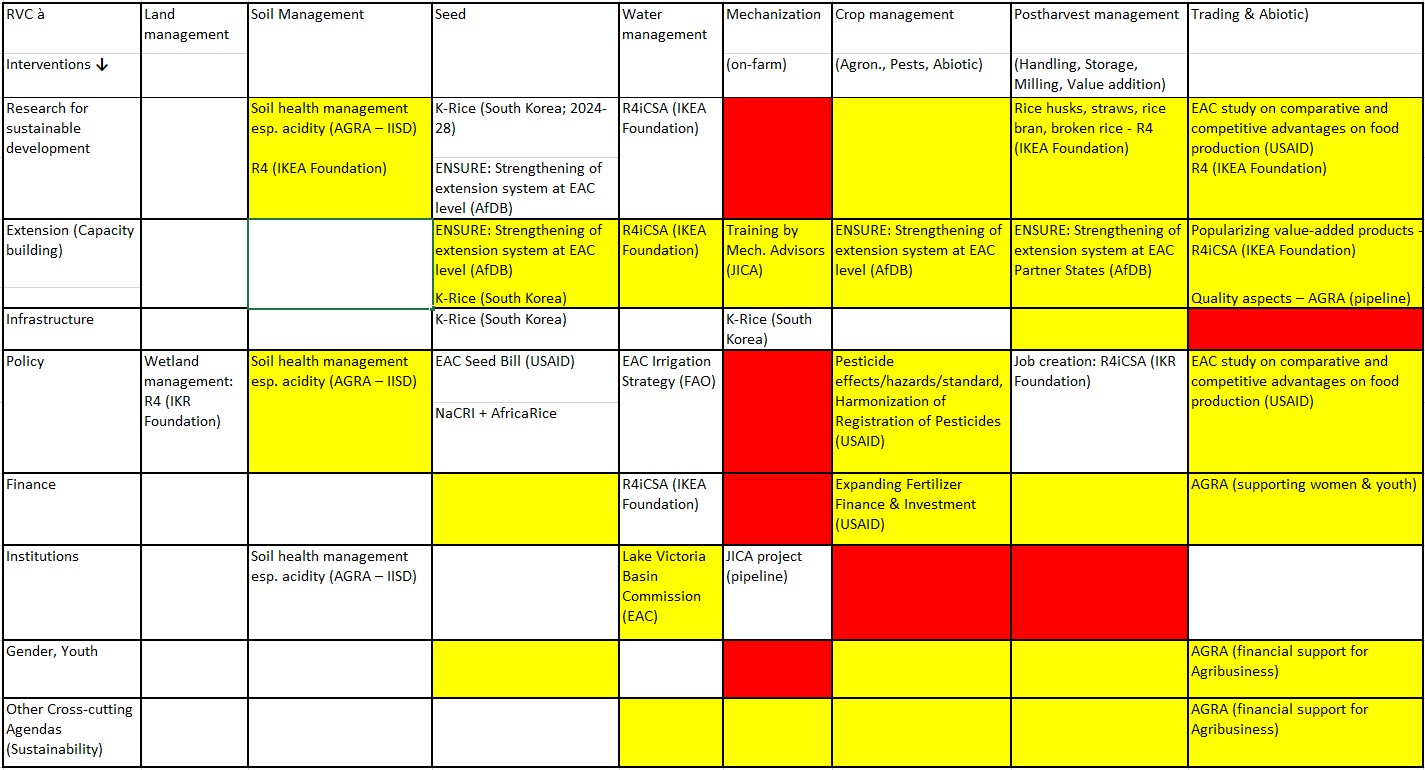
Review of concept notes on NRDS-2
Given the needs (demand) of ERDS elucidated already under the ERDSIP, the participants prioritized from among the enlisted 66 activities using the gaps identified through the SIEM (table above). While prioritizing the concepts for submission to stakeholders, the participants also emphasized on the consensus amongst the Partner States’ demands. For this purpose, the participants were divided into two groups with at least one representative from each EAC Partner State present in each group. Under the guidance of a mutually assigned Leader for each group, the members of the two groups analyzed the gaps more closely and identified activities that are of utmost importance under a maximum of 10 concepts. To improve the strategic outcomes of the interventions, 2 or more related activities that could influence through their additive effects were packed (wherever possible) under the prioritized concepts (table below).
Through this exercise, group-1 identified 10 concepts that would serve ERDS’ strategic objectives #1 and 2 (of 5). Group-2 prioritized 6 concepts for serving the expected outcomes under the ERDS’ strategic objectives #3, 4 and 5 (of 5). After prioritization of these two sets of concepts by the two separate groups, the group leaders presented the priorities in a plenary session and collectively peer-reviewed all the 16 concepts. Suggestions made from such a plenary discussion were incorporated by the group leaders. It should be noted that the identified concepts need to be elaborated further with goal, objectives, project components and expected outputs, for a better understanding by the stakeholders. The following table summarizes the proposed titles and activities for the 16 concepts prioritized by the participants: –
| Sl.
No |
Concept title | Proposed activities |
| 1 | Identify and map suitable areas for rice investments | • Map suitable rice cultivation areas for small, medium, and large-scale investments |
| 2 | Strengthen capacity (Human, Equipment and Infrastructure) of NARS to develop and promote technologies, innovations and management practices on thematic areas | • Train rice researchers, technicians, and extension service providers on thematic areas.
• NARS equipped with required research infrastructures for selection of breeding lines, pest and disease evaluation, seed testing, and soil testing |
| 3 | Support establishment of sustainable quality rice seed system in the EAC region
|
• A regional seed bank at the Centre of Excellence in Uganda Established
• Public-Private sector (seed producer) led rice seed trade and other rice agro-inputs distribution system within the EAC region established |
| 4 | Promote sustainable rice cultivation technologies, innovations and management practices
|
• Profile and share best practices on efficient water management technologies in irrigated and rain-fed ecologies
• Build capacity of NARS and extension in identifying and disseminating cost efficient rice production technologies on land preparation, planting, weeding, soil fertility management and Harvesting • Build capacity of local government, technicians, engineers, Water Users Associations in efficient water management |
| 5 | Strengthen rice producer organizations in production, postharvest handling and marketing | • Train and strengthen producers to work in groups and legally recognized associations |
| 6 | Upgrade milling technology and enhance capacity of rice actors along the value chain in quality improvement
|
• Build capacity of millers and machine operators
• Capacity building of value chain actors on postharvest management • Create awareness and operationalize the EAC rice standards • Build technical capacity to attract investments in local manufacturing of improved machineries • Upgrade milling technology in the region through tax Regulations |
| 7 | Support development and commercialization of diverse rice value added products | • Profile the existing rice products in regional markets
• Identify and promote commercialization of new rice products and by-products |
| 8 | Enhance financial literacy inclusion programs and access to finance for the rice value chain actors | • Build capacity of value chain actors in financial literacy
• Lobby financial institutions to develop affordable financial solutions for rice value chain activities |
| 9 | Support operationalization of the regional mechanization center of excellence | • Strengthen and operationalize a regional mechanization center of excellence for developing appropriate technologies for the region |
| 10 | Organize regional multi-stakeholder rice platform events | • Organize EAC rice investor conferences every year |
| 11 | Operationalize the OSBP Act 2016 | • Propose an amendment to include DRC and RSS; Somalia in Part(x)51 (2) for broader regional integration
• Target upgrading 3 OSBP infrastructures per Partner State to enhance trade facilitation and efficiency • Drive efforts to facilitate the effective implementation of the revised OSBP Act to streamline cross-border trade processes |
| 12 | Enhancing Rice Trade and Sustainability through Market Information and Knowledge Portal | • Establish an online platform to provide real-time market data, price trends, and best practices for rice trading, benefiting stakeholders across the value chain
• Conduct training sessions, workshops, and awareness campaigns to educate rice industry participants on market dynamics, trade regulations, and sustainable practices |
| 13 | Capacity Building in Data Management | • Recruit two individuals in every Partner State to focus on data analytics roles
• Conduct comprehensive training sessions to upskill recruited personnel in advanced data analytics techniques and tools |
| 14 | Improve Efficiency to Lower Cost of Rice Production | • Analyze the impact of CET rates, stays, and duty remission on the rice sector to identify areas for improvement
• Educate key stakeholders on the detrimental effects of policy misalignment in the rice industry to foster better decision-making • Support the implementation of zero tariff rates on rice-related farm inputs within the EAC to reduce production costs and enhance competitiveness |
| 15 | Improve Collaboration and Coordination | • Implement policies and financial support programs to encourage the local production of agricultural inputs and machinery within the EAC region
• Promote the establishment of associations comprising fabricators and manufacturers across EAC Partner States to enhance collaboration and knowledge sharing • Establish a dedicated forum for rice stakeholders in the EAC region to facilitate discussions, promote cooperation, and address challenges collectively |
| 16 | Promote Sustainable Growth of the Rice Value Chain | • Encourage private sector involvement in developing and offering climate-smart technologies and services
• Provide training on entrepreneurship, sustainable rice production, and circular economy principles, with a focus on empowering youth and women |
Way forward
The ERP members agreed that the data on the agreed indicators shall be collected and submitted to EAC Secretariat by mid-July. EAC Secretariat in collaboration with CARD Secretariat will then collate the data for in-country and regional validation by October. The ERP members have also agreed to plan and share the outcomes of M&E exercise with wider stakeholders by organizing EAC’s first Annual Rice Sector Review Meeting (EAC-ARSRM) by the last week in January 2025.
